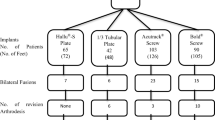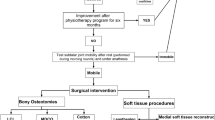Abstract
Introduction
Flexor digitorum longus transfer and medial displacement calcaneal osteotomy have shown favourable results in the treatment of adult acquired flat foot deformity stage 2. Little is known about the resorbable interference screw for tendon fixation and postoperative patient satisfaction though. Moreover possible changes of radiographic parameters at final follow-up, possible implant-associated complications and differences concerning clinical results at final follow-up to other studies using bone tunnel techniques for fixation of the FDL tendon were investigated.
Materials and methods
21 feet in 21 patients with a mean age of 51 years were evaluated pre- and postoperatively after a standardised operative procedure using MDCO and FDL transfer with interference screw fixation. Patients were evaluated with the American Orthopaedic Foot and Ankle Society Hindfoot Score and the Visual Analogue Scale at an average follow-up of 20 months. Hindfoot radiographic parameters were evaluated according to AOFAS guidelines. For statistical analysis SPSS v.15.0.1 was used.
Results
The average AOFAS Score (from 42 to 95 points) and VAS (from 0.5 to 8 points) both increased significantly (p < 0.001 each) from preoperative to final follow-up as well as the hindfoot valgus (from 10 to 4 degrees (p = 0.005)) and the lateral talo-first metatarsal angle (from 13.6 preoperative to 5.2° at follow-up). 88 percent of patients evaluated the postoperative result with “very good” or “good”. Implant-associated complications could not be detected.
Conclusion
We conclude that interference screw fixation for FDL transfer is a safe and promising operative technique, allowing a smaller skin incision without disrupting the normal interconnections at the knot of Henry, while achieving very high patient satisfaction and improving postoperative function as well as relieving pain. This method is technically easy to perform, has a low complication risk and we, therefore, recommend this fixation technique in patients with adult acquired flatfoot deformity stage 2.







Similar content being viewed by others
References
Brodsky JW, Zubak JJ, Pollo FE et al (2004) Preliminary gait analysis results after tibial tendon reconstruction: a prospective study. Foot Ankle Int 25:96–100. doi:10.1177/107110070402500210
Bussewitz BW, Hyer CF (2010) Interference Screw Fixation and Short Harvest Using Flexor Digitorum Longus (FDL) Transfer for Posterior Tibial Tendon Dysfunction: a Technique. J Foot Ankle Surg 49(5):501–503. doi:10.1053/j.jfas.2010,06.019
Chadwick C, Whitehouse SL, Saxby TS (2015) Long-term follow-up of flexor digitorum longus transfer and calcaneal osteotomy for stage II posterior tibial tendon dysfunction. Bone Joint J 97(3):346–352. doi:10.1302/0301-620X.97B3.34386
Clanton T, Perlman M (2002) Interference screw fixation of tendon transfers in the foot and ankle. Foot Ankle Int 23:355–356. doi:10.1177/107110070202300413
Den Hartog B (2001) Flexor digitorum longus transfer with medial displacement calcaneal osteotomy. Foot Ankle Clin 6:61–76. doi:10.1016/S1083-7515(03)00079-2
Fayazi AH, Nguyen HV, Juliano PJ (2002) Intermediate term follow-up of calcaneal osteotomy and flexor digitorum longus transfer for treatment of posterior tibial tendon dysfunction. Foot Ankle Int 23:1107–1111. doi:10.1177/107110070202301205
Frey C, Shereff M, Greenidge N (1990) Vascularity of the posterior tibial tendon. J Bone Joint Surg Am 72:884–888
Guyton GP, Jeng C, Krieger LE et al (2001) Flexor digitorum longus transfer and medial displacement calcaneal osteotomy for the treatment of posterior tibial tendon dysfunction: a middle term clinical follow-up. Foot Ankle Int 22:627–632. doi:10.1177/107110070102200802
Helal B (1990) Cobb repair for tibialis posterior tendon rupture. J Foot Surg 29:349–358
Holmes GB Jr, Mann RA (1992) Possible Epidemiological Factors Associated with Rupture of the Posterior Tibial Tendon. Foot Ankle Int 13:70–79. doi:10.1177/107110079201300204
Hui JHP, Goh JHC, Lee EH (1998) Biomechanical study of tibialis anterior tendon transfer. Clin Orthop Relat Res 349:249–255
Ivanic GM, Hofstaetter SG, Trnka HJ (2006) The acquired flatfoot: mid-term results of the medial displacement calcaneal-osteotomy with flexor digitorum longus transfer. Z Orthop Ihre Grenzgeb 144(6):619–625. doi:10.1055/s-2006-955190
Jahss MH (1982) Spontaneous rupture of the tibialis posterior tendon: clinical findings, tenographic studies, and a new technique of repair. Foot Ankle Int 3:158–166. doi:10.1177/107110078200300308
Johnson KA (1983) Tibialis posterior tendon rupture. Clin Orthop 177:140–147
Johnson KA, Strom DE (1989) Tibialis posterior tendon dysfunction. Clin Orthop 239:196–206
Kettelkamp DB, Alexander HH (1969) Spontaneous rupture of the posterior tibial tendon. J Bone Joint Surg Am 51(4):759–764
Kitaoka HB, Alexander IJ, Adelaar RS et al (1994) Clinical rating systems for the ankle- hindfoot, midfoot, hallux, and lesser toes. Foot Ankle Int 15(7):349–353. doi:10.1177/107110079401500701
Lee KM, Chung CY, Park MS et al (2010) Reliability and Validity of Radiographic Measurements in Hindfoot Varus and Valgus. J Bone Joint Surg Am 13:2319–2327. doi:10.2106/JBJS.I.01150
Louden KW, Ambrose CG, Beaty SG et al (2003) Tendon transfer fixation in the foot and ankle: a biomechanical study evaluating two sizes of pilot holes for bioabsorbable screws. Foot Ankle Int 1:67–72. doi:10.1177/107110070302400111
Myerson MS (1997) Adult acquired flat foot deformity: treatment of dysfunction of the posterior tibial tendon. Instr Course Lect 46:393–405
Myerson MS, Badekas A, Schon LC (2004) Treatment of stage II posterior tibial tendon deficiency with flexor digitorum longus transfer and calcaneal osteotomy. Foot Ankle Int 25:445–450. doi:10.1177/107110070402500701
Myerson MS, Corrigan C, Thompson F et al (1995) Tendon transfer combined with calcaneal osteotomy for the treatment of posterior tibial tendon insufficiency: a radiological investigation. Foot Ankle Int 16:712–718. doi:10.1177/107110079501601108
Niki D, Hirano T, Okada H et al (2012) Outcome of medial displacement calcaneal osteotomy for correction of adult-acquired flatfoot. Foot Ankle Int 33:940–946. doi:10.3113/FAI.2012.0940
Nyska M, Parks BG, Chu IT et al (2001) The contribution of medial calcaneal osteotomy to the correction of flatfoot deformities. Foot Ankle Int 22:278–282. doi:10.1177/107110070102200402
Oh I, Williams BR, Ellis SJ et al (2011) Reconstruction of the symptomatic idiopathic flatfoot in adolescents and young adults. Foot Ankle Int 32:225–232. doi:10.3113/FAI.2011.0225
Parsons S, Naim S, Richards PJ et al (2010) Correction and Prevention of Deformity in Type II Tibialis Posterior Dysfunction. Clin Orthop Relat Res 468:1025–1032. doi:10.1007/s11999-009-1122-1
Saltzman CL, el-Khoury GY (1995) The hindfoot alignment view. Foot Ankle Int 16:572–576. doi:10.1177/107110079501600911
Sabonghy EP, Wood RM, Ambrose CG et al (2003) Tendon transfer fixation: comparing a tendon to tendon technique vs. bioabsorbable interference-fit screw fixation. Foot Ankle Int 3:260–262. doi:10.1177/107110070302400311
Schuh R, Gruber F, Wanivenhaus A et al (2013) Flexor digitorum longus transfer and medial displacement calcaneal osteotomy for the treatment of stage II posterior tibial tendon dysfunction: kinematic and functional results of fifty one feet. Int Orthop 37:1815–1820. doi:10.1007/s00264-013-2071-6
Scranton PE, Lawhon SE, McDermott JE (2005) Bone suture anchor fixation in the lower extremity: a review of insertion principles and comparative biomechanical evaluation. Foot Ankle Int 7:516–519. doi:10.1177/107110070502600703
Sullivan RJ, Gladwell HA, Aronow MS et al (2006) An in vitro study comparing the use of suture anchors and drill hole fixation for flexor digitorum longus transfer to the navicular. Foot Ankle Int 27:363–366. doi:10.1177/107110070602700508
Tellisi N, Lobo M, O’Malley M et al (2008) Functional outcome after surgical reconstruction of posterior tibial tendon insufficiency in patients under 50 years. Foot Ankle Int 29:1179–1183. doi:10.3113/FAI.2008.1179
Trnka HJ, Ivanic G (2004) Surgical Correction of the Adult Acquired Flat Foot. Operat Orthop Traumatol 16:75–88. doi:10.1007/s00064-004-1095-x
Wacker JT, Hennessy MS, Saxby TS (2002) Calcaneal osteotomy and transfer of the tendon of flexor digitorum longus for stage-II dysfunction of tibialis posterior: three- to Five-year results. J Bone Joint Surg Br 1:54–58. doi:10.1302/0301-620X.84B1.11847
Wukich D, Rhim B, Lowery NJ et al (2008) Biotenodesis screw for fixation of FDL transfer in the treatment of adult acquired flatfoot deformity. Foot Ankle Int 7:730–734. doi:10.3113/FAI.2008.0730
Zanolli DH, Glisson RR, Nunley JA 2nd et al (2014) Biomechanical Assessment of Flexible Flatfoot Correction: comparison of Techniques in a Cadaver Model. J Bone Joint Surg Am 96(6):e45. doi:10.2106/JBJS.L.00258
Author information
Authors and Affiliations
Corresponding author
Ethics declarations
Disclosure
The Authors received no financial support for the research, authorship, and/or publication of this article. No benefits in any form have been received or will be received from a commercial party related directly or indirectly to the subject of this article.
Additional information
C. G. Charwat-Pessler and S. G. Hofstaetter share joint primary authorship.
Rights and permissions
About this article
Cite this article
Charwat-Pessler, C.G., Hofstaetter, S.G., Jakubek, D.E. et al. Interference screw for fixation of FDL transfer in the treatment of adult acquired flat foot deformity stage II. Arch Orthop Trauma Surg 135, 1369–1378 (2015). https://doi.org/10.1007/s00402-015-2295-6
Received:
Published:
Issue Date:
DOI: https://doi.org/10.1007/s00402-015-2295-6




